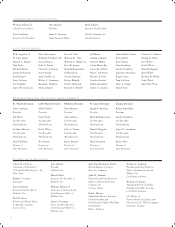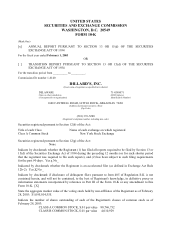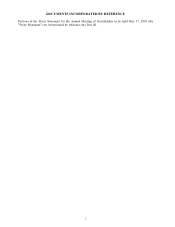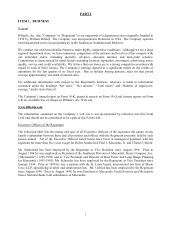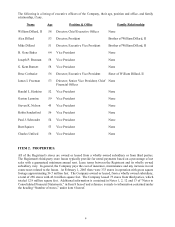Dillard's 2002 Annual Report Download - page 16
Download and view the complete annual report
Please find page 16 of the 2002 Dillard's annual report below. You can navigate through the pages in the report by either clicking on the pages listed below, or by using the keyword search tool below to find specific information within the annual report.
Inventory in comparable stores at February 1, 2003 increased 2% comparing to inventory in comparable stores at
February 2, 2002. This increase was due to lower than expected sales in the fourth quarter of fiscal 2002.
Cost of sales as a percentage of sales decreased to 67.5% during 2001 compared with 67.8% for 2000. This decrease
is due to a higher level of markups and lower shrinkage levels, partially offset by slightly higher level of markdowns
during 2001 compared with 2000. The gross margin improvement is also attributable to a greater percentage of sales
in categories with higher gross margins such as cosmetics and shoes, accessories and lingerie. Comparable store
inventories for 2001 decreased by 5% from 2000 levels as the Company continued to focus on maintaining
appropriate inventory levels.
Effective January 30, 2000, the Company changed its method of accounting for inventories under the retail inventory
method. The change principally related to the Company’s accounting for vendor markdown allowances, from
recording these allowances directly as a reduction of cost of sales to recording such allowances as a reduction of
inventoriable product cost. Historically, the vendor/retailer arrangement provided for the Company to receive
allowances from vendors when gross margin rates fell below stipulated levels. During fiscal 2000, the Company and
certain vendors revised the vendor/retailer arrangement whereby the vendors were providing up-front allowances in
the form of a fixed percentage discount off of purchases. The Company viewed the changes in the vendor
arrangements as a new purchasing model that will enhance its merchandising decisions. Since the vendor allowances
were directly related to purchases, the Company accounted for such fixed discount arrangements as a reduction of
inventoriable product cost. As the Company moves toward the new purchasing model, it plans to continue to
negotiate up-front discounts with its vendors. As such, the Company no longer views vendor markdown allowances
as direct reductions of markdowns, but rather as overall vendor discounts on inventory purchases, along with the up-
front product discounts noted above. Accordingly, the Company has changed its accounting method for markdown
allowances to record such allowances as a reduction of inventoriable product cost. In addition, and as a result of this
change, the Company has also changed its method of accounting for certain retail price adjustments, from recording
such price adjustments as a reduction of initial markup to recording them as markdowns under the retail inventory
method. The Company believes that its change in accounting method will result in improved merchandising and
buying decisions. The cumulative effect of the accounting change as of January 30, 2000 was to decrease net income
for fiscal year 2000 by $130 million, net of tax, or $1.42 per share. The effect of adopting the new method was to
increase both income before extraordinary item and net income for fiscal 2000 in the amount of $30 million ($.33 per
share).
Expenses
Expenses as a percentage of sales for the past three years were as follows:
2002 2001 2000
Advertising, selling, administrative and
general expenses 27.3% 26.9% 25.9%
Depreciation and amortization 3.8 3.8 3.5
Rentals .9 .9 .9
Interest and debt expense 2.3 2.5 2.8
Advertising, selling, administrative and general (“SG&A“) expenses increased to 27.3% of sales for fiscal 2002
compared to 26.9% for fiscal 2001. The percentage increase is primarily due to a lack of sales leverage as SG&A
expenses decreased $27.4 million in 2002 compared to 2001. On a dollar basis significant decreases were noted in
payroll, utilities and supplies partially offset by a $23.8 million increase in bad debt expenses, which includes an
increase in the allowance for doubtful accounts of $12.4 million during 2002 compared to 2001. Depreciation and
amortization as a percentage of sales remained flat during fiscal 2002 principally due to lower amortization expenses
during 2002 compared to 2001 as a result of the non-amortization provisions of SFAS No. 142 combined with a lack
of sales leverage from the 3% decline in comparable store sales during the year. Interest and debt expense as a
percentage of sales declined during fiscal 2002 as a result of the Company’s continuing focus on reducing its out-
standing debt levels and the reduction in variable short-term interest rates. The Company retired $340 million in long-
term debt and issued $40 million in new mortgage loans and $100 million in additional receivable financing during
2002.
10
SG&A expenses increased to 26.9% of sales for fiscal 2001 compared to 25.9% for fiscal 2000. This increase is due
principally to higher selling payroll, utilities, insurance and bad debt costs combined with a lack of sales leverage.
Depreciation and amortization as a percentage of sales increased during fiscal 2001 principally due to the 3% decline
in comparable store sales during the year and capital expenditures incurred to upgrade the Company’s store selling,
service and support systems. Interest and debt expense as a percentage of sales declined during fiscal 2001 as a result
of the Company’s continuing focus on reducing its outstanding debt levels and the reduction in variable short-term
interest rates. The Company retired $411 million in long-term debt and issued $50 million in new debt during 2001.


